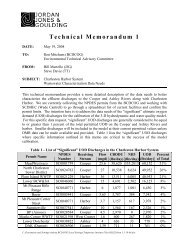Town of Summerville Planning Area - BCD Council of Governments
Town of Summerville Planning Area - BCD Council of Governments
Town of Summerville Planning Area - BCD Council of Governments
- No tags were found...
You also want an ePaper? Increase the reach of your titles
YUMPU automatically turns print PDFs into web optimized ePapers that Google loves.
Energy ElementOverviewThe Energy Element will discuss the type, quantity, and uses <strong>of</strong> energy in <strong>Summerville</strong>. It will discuss thecurrent energy resources utilized by the <strong>Town</strong> <strong>of</strong> <strong>Summerville</strong> and the current energy usage <strong>of</strong> the <strong>Town</strong>and its residents. The Energy Element will help the <strong>Town</strong> outline goals for the reduction <strong>of</strong> energy useand strategies by which to achieve these goals both within the <strong>Town</strong> limits and elsewhere within the<strong>Summerville</strong> <strong>Planning</strong> <strong>Area</strong>, as set forth by the <strong>Summerville</strong> <strong>Town</strong> <strong>Council</strong>.<strong>Summerville</strong> has abundant energy resources and several local and regional energy companies that willcontinue to provide energy for the <strong>Town</strong> and its residents far into the future. The <strong>Town</strong> has theopportunity to reduce their energy usage and save money while helping reduce pollution. There areseveral ways that the <strong>Town</strong> and its residents and businesses may reduce usage <strong>of</strong> traditional energysources. These options may include the use <strong>of</strong> solar energy, the use <strong>of</strong> transit, the use <strong>of</strong> architecture totake advantage <strong>of</strong> natural heating and cooling, and the placement <strong>of</strong> trees and landscaping in locationsthat take advantage <strong>of</strong> natural heating and cooling. A reduction in energy usage will not only help toplower energy costs to residents and businesses, but it will also improve the quality <strong>of</strong> life for residents <strong>of</strong>the <strong>Planning</strong> <strong>Area</strong>.BackgroundSince the 1950’s, the United States has increasingly become dependent on imported energy sources,primarily, but not exclusively, in the form <strong>of</strong> petroleum products. While there are some petroleumsources that are still available in the US and elsewhere in North America, the extraction <strong>of</strong> these sourcesis increasingly difficult, both from a cost standpoint and from the effect <strong>of</strong> the extraction on sensitivelands, waterways, or nearby ecosystems. These petroleum products are derived from crude oil with endproducts including gasoline, jet fuel, asphalt, fuel oil, waxes, asphalt, and other lubricants, as well asbase products for the manufacture <strong>of</strong> plastics. In 2010, the US is expected to import 53 percent <strong>of</strong> thepetroleum that is consumed in the country. While the US produces 10 percent <strong>of</strong> the world’s petroleum,it consumes nearly a quarter <strong>of</strong> all petroleum products that are extracted worldwide.Energy Element Page 1




